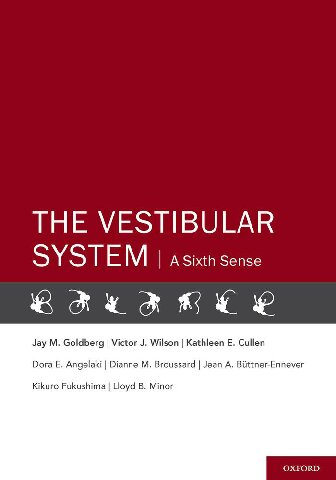

Most ebook files are in PDF format, so you can easily read them using various software such as Foxit Reader or directly on the Google Chrome browser.
Some ebook files are released by publishers in other formats such as .awz, .mobi, .epub, .fb2, etc. You may need to install specific software to read these formats on mobile/PC, such as Calibre.
Please read the tutorial at this link. https://ebooknice.com/page/post?id=faq
We offer FREE conversion to the popular formats you request; however, this may take some time. Therefore, right after payment, please email us, and we will try to provide the service as quickly as possible.
For some exceptional file formats or broken links (if any), please refrain from opening any disputes. Instead, email us first, and we will try to assist within a maximum of 6 hours.
EbookNice Team

Status:
Available0.0
0 reviews
ISBN 10: 0195167082
ISBN 13: 9780195167085
Author: Jay M Goldberg, Victor J Wilson, Kathleen E Cullen
Chapter 1: The Vestibular System in Everyday Life
1.1 Overview of the Vestibular System
1.2 Visual Acuity and the Vestibulo‑Ocular Reflex
1.3 Air‑Righting Reflex in the Cat
1.4 Post‑Rotational Reactions
1.5 Positional Alcohol Nystagmus
1.6 Motion Sickness
1.7 Vection Illusions
1.8 The Subjective Visual Vertical
1.9 Adaptive Plasticity
1.10 Path Finding and Spatial Orientation
1.11 Postural Control
1.12 Summary
1.13 Selected Readings
Chapter 2: Structure of the Vestibular Labyrinth
2.1 Gross and Microscopic Anatomy
2.2 Fine Structure of the Sensory Regions
2.3 Regional Variations in Cellular Architecture and Afferent Innervation
2.4 Efferent Innervation
2.5 Summary
2.6 Selected Readings
Chapter 3: Hair Cell Transduction
3.1 Mechanoelectric Transduction
3.2 Basolateral Currents
3.3 Neurotransmitter Release and Presynaptic Calcium Channels
3.4 Postsynaptic Mechanisms
3.5 Synaptic Transmission Involving Type I Hair Cells
3.6 Spike Encoding
3.7 Efferent Neurotransmission
3.8 Summary
3.9 Selected Readings
Chapter 4: Physiology of the Vestibular Organs
4.1 General Features of the Vestibular Organs
4.2 Semicircular Canals
4.3 Otolith Organs
4.4 Summary
4.5 Selected Readings
Chapter 5: The Efferent Vestibular System
5.1 Comparative Anatomy of Central Efferent Pathways
5.2 Responses of Afferents to Electrical Activation of the EVS
5.3 Responses of Efferents to Natural Stimulation
5.4 Efferent‑Mediated Responses of Afferents
5.5 Possible Functions of Efferents in Mammals
5.6 Summary
5.7 Selected Readings
Chapter 6: Neuroanatomy of Central Vestibular Pathways
6.1 Introduction
6.2 The Vestibular Nuclei: Subdivisions and Anatomical Organization
6.3 Vestibulo‑Ocular and Optokinetic Systems
6.4 Vestibulospinal Systems
6.5 Vestibulocerebellar Relations
6.6 Vestibulo‑Autonomic Connections
6.7 Vestibular Connections with the Neocortex
6.8 Pathways Involving the Hippocampal Formation
6.9 Summary
6.10 Selected Readings
6.11 List of Abbreviations
Chapter 7: Synaptic Mechanisms in the Vestibular Nuclei
7.1 Historical Perspective
7.2 Basic Circuitry of the Vestibular Nuclei
7.3 Neurotransmitters in the Vestibular Nuclei
7.4 Properties of Individual Neurons
7.5 Central Projections of Regular and Irregular Afferents
7.6 Convergence from Separate Vestibular Organs
7.7 Convergence from Somatosensory Receptors
7.8 Summary
7.9 Selected Readings
Chapter 8: An Oculomotor Tutorial
8.1 Overview and Classification of Eye Movement Types
8.2 Ocular Structure and Functional Implications
8.3 Gaze Redirection
8.4 Gaze Stabilization
8.5 Interactions Between Eye and Head Movements
8.6 Summary
8.7 Selected Readings
Chapter 9: Vestibulo‑Ocular Reflexes
9.1 Semicircular‑Canal–Related Angular VOR
9.2 Otolith‑Ocular Reflexes
9.3 Summary
9.4 Selected Readings
Chapter 10: The Vestibulospinal System and Postural Control
10.1 Reflexes Versus Multisensory Strategies
10.2 Multisensory Strategies
10.3 Vestibular Reflexes: General Considerations
10.4 Vestibulocollic Reflexes (VCR)
10.5 Control Systems Analysis of the Head–Neck Plant
10.6 Vestibulospinal and Neck Reflexes Acting on the Limbs
10.7 Summary
10.8 Selected Readings
Chapter 11: Signal Processing in Vestibular Nuclei of Alert Animals During Natural Behaviors
11.1 Introduction
11.2 Classes of Neurons in Head‑Restrained, Alert Monkeys
11.3 Dynamics of Neuronal Responses
11.4 Response to Linear Translations in Alert Head‑Restrained Monkeys
11.5 Interactions with the Oculomotor Pathways That Control Pursuit Eye Movements
11.6 Integration of Inputs from Vestibular and Optokinetic Pathways
11.7 Integration of Vestibular and Proprioceptive Inputs
11.8 Differential Processing of Active Versus Passive Head Movements
11.9 Vestibular Processing Depends on Current Gaze Strategy
11.10 Summary
11.11 Selected Readings
Chapter 12: The Cerebellum and the Vestibular System
12.1 Overview of Signal Processing in the Cerebellum
12.2 Nodulus and Ventral Uvula
12.3 Flocculus and Ventral Paraflocculus
12.4 The Vermis of the Anterior and Posterior Lobes
12.5 The Deep Cerebellar Nuclei
12.6 Summary
12.7 Selected Readings
Chapter 13: Learning and Compensation in the Vestibular System
13.1 Motor Learning in the Vestibulo‑Ocular Reflex
13.2 Compensation for Vestibular Damage
13.3 Summary
13.4 Selected Readings
Chapter 14: Cortical Representations of Vestibular Information
14.1 Introduction
14.2 Historical Perspective
14.3 Multiple Representations of Vestibular Signals in the Cerebral Cortex
14.4 Ascending Vestibular Pathways through the Thalamus
14.5 Descending Cortical Information Affecting Vestibular Nuclei
14.6 Vestibular Influences in the Head‑Direction Circuit of the Limbic System
14.7 Summary
14.8 Selected Readings
Chapter 15: Reference Frames for the Coding of Vestibular Signals
15.1 Definitions of Coordinate Systems and Reference Frames
15.2 Head‑Versus Body‑Centered Reference Frames: Vestibular‑Neck Proprioceptive Interactions
15.3 Head‑Versus Eye‑Centered Reference Frames for Self‑Motion Perception
15.4 Head‑Versus World‑Centered Reference Frames: Canal‑Otolith Convergence
15.5 Computational Solution for the Two Ambiguities of Peripheral Vestibular Sensors
15.6 Summary
15.7 Selected Readings
Chapter 16: Clinical Manifestations of Peripheral Vestibular Dysfunction
16.1 Prevalence and Impact of Vestibular Disorders
16.2 Diagnosis of Vestibular Disorders
16.3 Planes of Individual Canals and Direction of Eye Movements
16.4 Recovery of the Horizontal VOR After Unilateral Labyrinthectomy
16.5 Multisensory Control of Posture
16.6 Disorders of Otolith Function
16.7 Clinical Tests of Vestibular Function
16.8 Future Directions
16.9 Summary
16.10 Selected Readings
explain the vestibular sense
vestibular system ap psych
vestibular system explained
the vestibular system is
in the vestibular system hair cells are found in the
Tags: Jay M Goldberg, Victor J Wilson, Kathleen E Cullen, Vestibular System